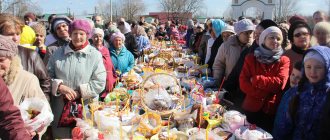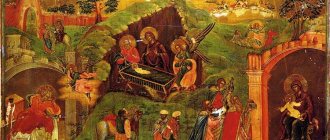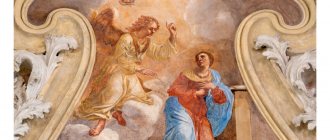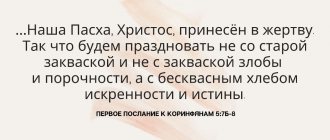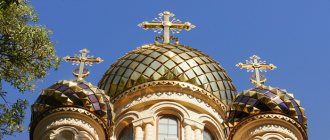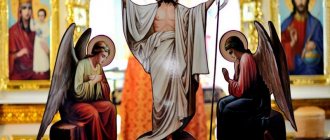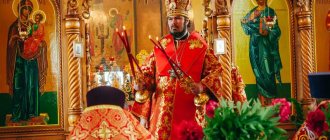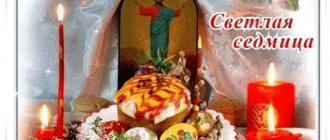EASTER or CHRIST'S RESURRECTION?
It would seem that the meaning of Easter - as we usually call our main holiday - is quite transparent. Alas! Experience tells a different story. I will give only two of the most typical examples.
A lesson in one “Orthodox gymnasium”. Wanting to identify the level of knowledge of the children, I ask: “How did Christ and the apostles celebrate Easter?” – A reasonable answer follows: “They ate Easter cakes and colored eggs”! There is nothing to object to this! What about the adults?
Easter night breaking the fast in one church. Indeed, we eat eggs and Easter cakes (and not only). “Suddenly” an important thought occurs to one already middle-aged singer, and he turns in confusion to the priest (with a theological education). “Father! So we keep singing and singing “Christ is Risen!”, and call the holiday “Easter”! So, after all, Jews celebrate Easter, but do not believe in Christ at all! Why is that?!"
This is no exception: what we perceive from childhood on an everyday level as some kind of beautiful ritual seems to us to be self-evident and does not require study.
Let’s give ourselves an “Easter lesson” and ask: what associations does the Easter greeting “Christ is Risen!” give rise to in our minds? - “Truly he is risen!”
A night religious procession with candles, everyone will immediately answer, joyful singing and mutual kisses. Dishes familiar from childhood appear on the home table - red and painted eggs, rosy Easter cakes, vanilla-scented Easter cottage cheese.
Yes, but this is only the external attributes of the holiday, a thoughtful Christian will object. – And I want to know why our holiday of the Resurrection of Christ is usually called the Hebrew word “Easter”? What is the connection between Jewish and Christian Passover? Why did the Savior of the world, from whose birthday humanity begins to count the New Era, have to die and be resurrected? Couldn't the all-good God have established a New Union (Covenant) with people in a different way? What is the symbolism of our Easter services and holiday rituals?
Easter Orthodox Traditions
Easter is one of the oldest holidays, which has its own centuries-old traditions.
Easter service
It is customary for Orthodox Christians to celebrate Easter in church. The most solemn service is Easter. It begins shortly before midnight: the Midnight Office is served, during which the Shroud is taken out and incense is performed around it, and subsequently the shrine is returned to the altar.
An obligatory stage of the festive service is the procession around the temple, marking the procession towards the risen Savior. The procession makes its way under the incessant ringing of church bells, which subsides only after the Orthodox, led by priests, approach the closed doors of the western entrance to the temple. After pronouncing certain words, the doors open and everyone enters the temple.
Around midnight, Easter Matins begins, which continues with the Divine Liturgy. The service usually lasts until 2-3 am and ends with the priests celebrating Christ with each other and with the parishioners.
In large churches with a huge flock, the priest usually only makes a speech, ending with the threefold phrase: “Christ is Risen!” This phrase encapsulates the entire essence of the Orthodox faith.
Christening
On Easter it is customary to greet each other in a special way. At the end of Matins, after singing “Let us embrace each other, shouting: brethren! and we will forgive all those who hate us through the resurrection,” the Orthodox say and answer each other: “Christ is Risen!” - “Truly He is Risen!”, after which they kiss three times on the cheeks.
This is the way you should greet each other throughout the next 40 days.
Easter meal
Immediately after the festive service, Orthodox Christians go to the refectory or to their home and begin to break their fast, that is, to eat foods prohibited during Lent. The central place on the table is occupied by a butter cake or paska, as it is commonly called in recent times. It is baked the day before, and at the end of the service it is consecrated in the temple. Initially, Easter was called cheese baba, for the preparation of which cottage cheese and a large number of chicken eggs were used.
Cottage cheese Easter has the shape of a truncated pyramid, symbolizing Mount Golgotha, on which the Savior was crucified. Eating Easter on this day represents the eternal victory of life over death, good over evil. Usually Orthodox Christians bring Easter, Easter cakes and eggs to the temple for consecration in wicker baskets decorated with colored ribbons, flowers, and Easter attributes.
Painted eggs
Painted eggs are a symbol of the Holy Sepulcher, which hides eternal life. The shell is the stone that was used to close the entrance to the rock where Jesus was buried, and the traditional red color, in which it was customary to paint eggs from time immemorial, is the personification of the suffering and shed blood of the Savior.
The origins of the tradition of giving eggs to each other originate in the New Testament. After the Resurrection, Christ appeared to Mary Magdalene, who reported the good news to the Apostles. She also appeared in Rome, where she spoke about the life, miracles and teachings of Christ to Tiberius himself, the Roman emperor. To prove the miracle of the Resurrection to the unbelieving ruler, Mary Magdalene took a white chicken egg in her hands and with the words “Christ is Risen!” handed it over, turning red in a matter of seconds, to the astonished Tiberius.
Painted eggs are a symbol of the Holy Sepulcher, which hides eternal life
Easter festivities
In Rus', it was customary to begin folk festivities immediately after visiting church. Dressed in their best, people did not hide their joy and good mood. Laughter and music were heard everywhere, fairs began to take place in the central squares, where brisk trade was carried out, and artisans demonstrated all their skills.
On this day, it is customary to engage in charity work: feeding the poor, giving things to orphans, leaving the homeless overnight.
In the evening, after sunset, it was customary to burn an Easter bonfire in central squares and streets, near churches and cemeteries, or right on the roads, symbolizing the victory of light over darkness, as well as the Light of God, enlightening all nations after the Resurrection of Christ.
Observing Easter traditions is a sacred matter for all Orthodox Christians. But without humility, kindness and mercy, even strict adherence to all canons will be a waste. Remembering the life of Christ and following him are the main indicators of a true believer.
Prototypes: “Earthly Easter”
“Observe the month of Abib (Nisan), and keep the Passover to the Lord your God, for in the month of Abib the Lord your God brought you out of Egypt by night” (Deuteronomy 16:1)
The historical and symbolic basis of the Jewish Passover is the epic events of the book of Exodus. It tells about the four-century period of Egyptian slavery, in which the Jewish people were oppressed by the pharaohs, and the wonderful drama of their liberation. Nine punishments (“plagues of Egypt”) were brought down on the country by the prophet Moses, but only the tenth made the cruel heart of the pharaoh soften, who did not want to lose the slaves who were building new cities for him. It was the defeat of the Egyptian firstborns, which was followed by the “exodus” from the House of Slavery. At night, while waiting for the exodus to begin, the Israelites eat their first Passover meal. The head of each family, having slaughtered a one-year-old lamb (lamb or kid), anoints the doorposts with its blood (Ex. 12:11), and the animal itself, baked on the fire, is eaten, but so that its bones are not broken.
“Eat it this way: let your loins be girded, your sandals on your feet, and your staffs in your hands, and eat it with haste: this is the Passover of the Lord. And this very night I will walk through the land of Egypt and will strike every firstborn in the land of Egypt, from man to beast, and will bring judgment on all the gods of Egypt. I am the Lord. And your blood will be a sign on the houses where you are; and I will see the blood and pass by you, and there will be no destructive plague among you when I strike the land of Egypt” (Ex. 12:11-13).
So on the night of the first spring full moon (from the 14th/15th month of Abib, or Nisan) in the 2nd half of the 13th century before the birth of Christ, the exodus of the Israelites from Egypt took place, which became the most important event in Old Testament history. And Easter, which coincided with deliverance, became an annual holiday - a remembrance of the exodus. The very name “Passover” (Heb. Pesah - “passing”, “mercy”) indicates that dramatic moment (“tenth plague”) when the angel of the Lord who struck Egypt, seeing the blood of the Passover lamb on the doorposts of Jewish houses, passed passed by and spared the firstborn of Israel (Ex. 12:13).
Subsequently, the historical character of Easter began to be expressed by special prayers and a story about its events, as well as a ritual meal consisting of lamb meat, bitter herbs and sweet salad, which symbolizes the bitterness of Egyptian slavery and the sweetness of newfound freedom. Unleavened bread reminds us of hasty preparations. Four cups of wine accompany the Easter meal at home.
The night of the exodus became the second birth of the Israeli people, the beginning of its independent history. The final salvation of the world and victory over the “spiritual slavery of Egypt” will be accomplished in the future by God’s Anointed One from the line of King David - the Messiah, or, in Greek, Christ. This is how all the biblical kings were called at first, but the question of who would be the last in their ranks remained open. Therefore, every Passover night the Israelites waited for the appearance of the Messiah.
Easter and Radonitsa in 2022 – parent’s day
On the 9th day after Christ's Resurrection, the time of remembrance of the dead begins. The name comes from the word “joy”: on Parental Tuesday, the living bring the good news of the resurrection of the Lord to their ancestors. This year Radonitsa falls on May 11th. On Memorial Day, it is customary to pray for departed relatives.
The all-night evening service begins on Monday. People come to it to offer prayers for deceased loved ones. Also at this time, notes are left in churches so that the names of the dead are included in the morning liturgy. For commemoration, they prepare kutya, bake pancakes and treat friends with a request to pray for the repose of loved ones. The Church recommends to Radonitsa:
- invite a priest to conduct a funeral service or conduct a litany yourself;
- tidy up the graves of relatives and plant flowers on them;
- pray for the souls of the dead.
However, she does not approve of funeral meals in the cemetery: the roots of this custom go back to paganism. There is also no need to drink alcohol or leave a filled glass on the graves of relatives.
The souls of the departed do not need material things. For commemoration, prayer and good memory of a person are enough.
Performance: “Heavenly Easter”
“With all my heart I wished to eat this Easter with you before My suffering! I tell you, I will not eat it again until it is completed in the Kingdom of God” (Luke 22:15-16)
The Messiah-Christ, who came to deliver all people from the spiritual “slavery of Egypt,” takes part in the Jewish “Passover of expectation.” He completes it by fulfilling the Divine plan inherent in it, and thereby abolishes it. At the same time, the nature of the relationship between God and man changes radically: the temporary Union of God with one people, which has fulfilled its purpose, becomes “old” (“outdated”), and Christ replaces it with the New – and eternal! – Union-Covenant with all humanity During His last Passover at the Last Supper, Jesus Christ utters words and performs actions that change the meaning of the holiday. He Himself takes the place of the Passover sacrifice, and the old Passover becomes the Passover of the new Lamb, slain for the purification of people once and for all. Christ institutes a new Easter meal - the sacrament of the Eucharist - and tells the disciples about His imminent death as an Easter sacrifice, in which He is the New Lamb, slain “from the foundation of the world.” Soon He will descend into gloomy Sheol (Hades) and, together with all the people waiting for Him there, will make the great Exodus from the kingdom of death to the shining Kingdom of His Father. It is not surprising that the main prototypes of the Calvary sacrifice are found in the ritual of the Old Testament Easter.
The Passover lamb (lamb) of the Jews was “male, without blemish” and was sacrificed on the afternoon of the 14th of Nisan. It was at this time that the Savior died on the cross. Those executed had to be buried before dark, so the Roman soldiers, in order to speed up their death, broke the legs of two robbers who were crucified with the Lord. But, “coming to Jesus, they saw that He was already dead, and they did not break His legs<...>. For this happened in fulfillment of the Scripture: “Let not His bone be broken” (John 19:33, 36). Moreover, the very preparation of the Paschal lamb was a prototype of the Savior’s death on the cross: the animal was “crucified” on two cross-shaped stakes, one of which ran along the ridge, and the front legs were tied to the other.
This deepest relationship between the old and new Easter, their concentration (the abolition of one and the beginning of the other) in the person of Jesus Christ explains why the holiday of His Resurrection also retains Easter . “Our Passover is Christ sacrificed,” says the Apostle Paul (1 Cor. 5:7). Thus, in the new Easter, the final completion of the Divine plan for the restoration of fallen (“old”) man to his original, “paradise” dignity took place—his salvation. “The Old Easter is celebrated because of the salvation of the short-term life of the Jewish firstborn, and the new Easter is celebrated because of the granting of eternal life to all people,” this is how Saint John Chrysostom succinctly defines the relationship between these two celebrations of the Old and New Testaments.
Raw cottage cheese Easter with condensed milk and white chocolate
belchonock/Depositphotos.com
Ingredients
- 100 g white chocolate;
- 400 g cottage cheese;
- 200 g condensed milk;
- filling (dried fruits, candied fruits, nuts) - optional.
Preparation
Melt the chocolate in the microwave or in a water bath. Mix it with cottage cheese and condensed milk and puree with a blender. Add filler if desired. Place the curd mass in the mold and place under pressure.
Try it

